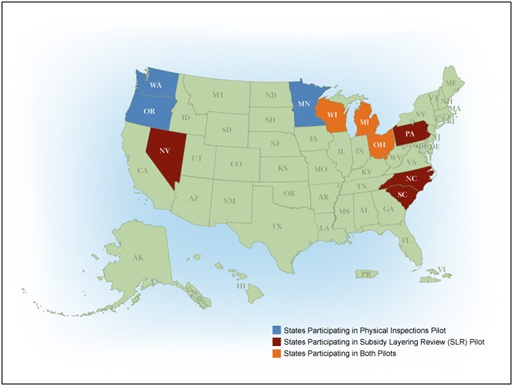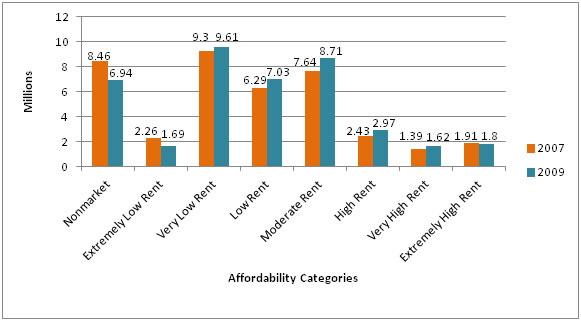
The Rental Policy Working Group solicits the input of stakeholders in affordable housing.
For the past year, a federal interagency Rental Policy Working Group has sought ways to streamline and eliminate redundancy in federal rental policy. The group consists of the White House Domestic Policy Council and three federal departments, all of which have significant rental housing programs: HUD, the U.S. Department of the Treasury, and the U.S. Department of Agriculture (USDA).
HUD provides eligible households with rental support through its public housing assistance and tenant-based Housing Choice Voucher programs. USDA provides rental support through the Rural Rental Assistance program, which offers multifamily project-based or direct tenant assistance to qualified residents in rural areas. The U.S. Treasury’s Low Income Housing Tax Credit Program provides federal income tax credits to developers of qualified low-income housing projects. A qualified project is one in which more than 20 percent of units are rent restricted and occupied by persons at 50 percent of the area median income (AMI), or in which 40 percent of the units are rent restricted and occupied by persons at 60 percent of the AMI.
The Rental Policy Working Group has solicited the input of stakeholders in affordable housing, including rental housing developers and managers as well as state and local officials, to improve rental policy coordination among all involved parties. These discussions identified several areas in which administrative changes could increase the effectiveness of federal rental policy and improve participant outcomes. The areas targeted for alignment and further study include physical property inspections, fair housing compliance, subsidy layering reviews, data sharing, income definitions and financial reporting, appraisals and market studies, energy efficiency, and capital needs requirements.
In July 2011, two administrative alignment pilot programs were announced, with the goal of streamlining physical property inspections and subsidy layering reviews. Because multifamily housing projects that receive federal funds are subject to physical inspection as a condition of assistance, using more than one federal funding stream on a property can result in multiple similar inspections. USDA is taking the lead in this realignment, which will develop a single, periodically scheduled physical inspection performed by one agency that will satisfy all agencies’ inspection criteria.

Ten states are participating in pilot programs to streamline physical inspections of properties and subsidy layering reviews.
As part of the physical inspection pilot, state-level teams in Michigan, Minnesota, Ohio, Oregon, Washington, and Wisconsin are merging all required physical inspections into a single inspection protocol with a defined frequency at each multifamily property. First-year estimates for this pilot program include $445,000 in governmental cost savings and $2.2 million in potential private sector cost savings — due to fewer inspections, reduced staff time and travel costs, and increased attention to regular duties.
The second pilot initiative addresses subsidy layering reviews to eliminate redundancy and wasted resources in affordable rental housing initiatives. HUD, USDA, and Treasury currently handle their required reviews differently. With USDA again taking the lead in this realignment, the initiative will effectively standardize and coordinate subsidy approval criteria and data-sharing efforts. State-level teams in Michigan, Nevada, North Carolina, Ohio, Pennsylvania, South Carolina, and Wisconsin have implemented pilots to align subsidy layering reviews. These efforts are expected to generate governmental savings through fewer reviews and consistent, better-informed decisions, whereas private-sector benefits include improved completion time and a reduced risk of closing delays. The results of this work will become the basis for a standardized format that can be applied in other states.
Watch for the Rental Policy Working Group’s continued efforts to seek input from interested parties on alignment strategies and to provide updates on initiatives, as well as the results of these pilot studies. Visit our pages on www.huduser.gov to learn more about this worthwhile, time- and cost-saving effort.
BACK TO THE TOP

Additions of newly constructed units to the U.S. housing inventory slowed between 2007 and 2009.
U.S. residential housing stock consisted of more than 128.2 million units in 2007, increasing to more than 130.1 million by 2009. These net totals are the outward expression of the nation’s extremely dynamic housing inventory during that timeframe. One tool housing analysts use to track housing dynamics is known as the Components of Inventory Change, or CINCH, which relies on American Housing Survey (AHS) data. When units are lost or added to the longitudinal AHS sample, CINCH analyses shed light on the underlying activity that leads to those losses or additions to the housing stock.
The events that together produce the total number of housing units are highlighted by examining inventory changes that occurred between 2007 and 2009 (see table). Many residential units (97.1%) that existed in 2009 were in the inventory two years earlier. However, additional units came online through new construction projects, restoration of previously uninhabitable units, conversions of nonresidential buildings into living quarters, new mobile home placements, and rehabilitation. Fire, natural disasters, and demolition destroyed other units, causing inventory reductions. Converting units to nonresidential use or combining two or more units also reduced the housing stock, as did temporary losses due to repair needs.
Changes in U.S. Housing Stock, 2007–2009
|
|
2007 housing stock: Published estimate
|
128,203,000
|
|
Units lost by demolition or disaster
|
-491,000 |
| Units added by new construction |
2,547,000 |
|
Units lost from mergers or conversions
|
-193,000 |
|
Units added by mergers or conversions
|
287,000 |
| House or mobile home moved out |
-411,000
|
|
House or mobile home moved in
|
470,000 |
|
Units lost to nonresidential use
|
-288,000 |
|
Units added from nonresidential use
|
261,000 |
|
Units badly damaged or condemned
|
-302,000 |
|
Units added from temporary losses due to structural problems
|
168,000 |
|
Units lost in other ways |
-400,000 |
|
Units added from other sources |
62,000 |
|
CINCH estimate of 2009 housing stock based on 2007 base
|
129,913,000 |
|
2009 housing stock: Published estimate |
130,112,000 |
Note: It is practically impossible to achieve a precise accounting of the change in the housing stock between surveys because the sample weights used in the AHS change between surveys.
The loss rate of 1.6 percent between 2007 and 2009 was similar to the two previous CINCH reporting periods (2003–2005 and 2005–2007). Types of units that experienced significant losses included rentals, especially low-rent units. The rate of growth slowed perceptibly from 4.1 percent in the earlier periods to 2.9 percent. Econometrica, the firm that conducted the study for HUD’s Office of Policy Development and Research, noted that “[t]he recent financial and economic crises appear to have had little effect on overall loss rates or types of losses. However, there was a substantial drop-off in overall additions and additions by new construction in the 2007–2009 periods.”
Together with this analysis is an inquiry into whether the number of rental units affordable to lower-income households grew or declined, and to what this growth or decline is attributable. The nation’s rental housing stock (occupied and vacant) expanded by an estimated 693,600 units between 2007 and 2009, according to the study, which examined the direction and magnitude of changes in the number of units distributed across eight different rent affordability categories:
- Nonmarket (subsidized or no cash rent);
- Extremely low rent (affordable with income ≤ 30 percent of area median income (AMI);
- Very low rent (affordable at 31–50 percent of AMI);
-
Low rent (affordable at 51–60 percent of AMI);
-
Moderate rent (affordable at 61–80 percent of AMI);
- High rent (affordable at 81–100 percent of AMI);
- Very high rent (affordable at 101–120 percent of AMI); and
- Extremely high rent (affordable at more than 120 percent of AMI).
The supply of rental units in the two most affordable categories (nonmarket and extremely low rent) fell between 2007 and 2009 by more than 2 million (see figure). Researchers attribute this drop to three factors: a decline in additions to the inventory, especially through new construction; a significant rise in the number of units changed from owner to rental stock; and movement across affordability categories — in particular, the most affordable units moving to higher rent categories.
Changes in Rental Stock Between 2007 and 2009

Source: Table ES-1 from U.S. Department of Housing and Urban Development, Office of Policy Development and
Research, Rental Market Dynamics: 2007–2009, May 2011, vi.
The study, Rental Market Dynamics: 2007–2009, uses American Housing Survey data to monitor the supply of all units in the rental market and to analyze their affordability. It is a complement of a larger inquiry into the dynamics of the nation’s housing stock.
BACK TO THE TOP
Residents of public housing typically pay 30 percent of their household’s adjusted income in rent; this figure is a conventional indicator of affordable housing in the United States. However, some flexibility applies when establishing a benchmark for the amount of rent that assisted households should pay. First, tenants have the option of paying rent based on 30 percent of their adjusted household income or paying a flat rate set by the public housing authority (PHA). The flat rate is often based on number of bedrooms and local rent levels as suggested by fair market rents (FMRs). Flat rent rates remain the same when and if a household’s income increases, and can appeal to assisted households with relatively higher incomes. Second, PHAs may set a minimum rent of up to $50 as long as a provision exists for a hardship exemption. Finally, in the case of the Housing Choice Voucher (HCV) program, PHAs may set their payment standard for housing vouchers to between 90 and 110 percent of the local FMR. HCV renters usually pay 30 percent of adjusted income, plus any part of the gross rent that exceeds the payment standard.
A recent analysis of rents and rent flexibility for HUD titled Study of Rents and Rent Flexibility includes information gleaned from interviews with people living in or waiting for public housing, in-person and telephone interviews with PHA staff, onsite visits, administrative data, and other research. Among their findings:
- Although 72 percent of PHAs set a minimum rent of $50, just 10 percent of assisted households pay the minimum rent set by their PHA. Only a small percentage (1%) of assisted households receive hardship exemptions.
- Opting for flat-rate rent payments is on the rise. In 2008, 15 percent of assisted households chose a flat rent, compared to 10 percent in 2004 and 6 percent in 2001.
- Households that pay flat rent tend to be employed and have higher incomes. In 2005, their average income was $28,150, compared to $9,426 for other assisted households.
- Compared to the FMR, PHA-set payment standards varied, with 32% below, 26% equal to, and 42% above the local FMR. The median payment standard declined by 3.6 percent between 2003 and 2008 (from $1,016 to $979 in 2008 dollars).

Rent burdens on residents of public housing is one of several issues considered when studying alternative rent structures. U.S. Census Bureau, Public Information Office (PIO)
Critics are concerned that the present income-based system, by allocating an additional 30 cents of every dollar earned toward rent, creates a disincentive for tenants to find employment and move up the economic ladder. Other critics note that the system encourages tenants to underreport income (so as to minimize rent payments), discourages households from adding another working adult, treats similar households inequitably, and is administratively complex and invasive. Alternatives to the present income-based rent structure explored in this study include a flat-rent or flat-subsidy system wherein all households, regardless of income level, would pay the same amount. A second approach would set rents at a low level that increases with each year of assistance, and subsidies for voucher holders would start high and decrease with each year of assistance. A hybrid system would feature a flat rent up to a certain income threshold and then charge a percentage-of-income rent above it. For example, a model considered in the study charged a flat rent of $150 per month to households earning less than $6,000 annually; households exceeding this threshold paid an additional percentage-of-income rent.
Models comparing household rent burdens under the proposed alternatives with the current system (assuming incomes were accurately reported) suggest that the current system, in which 87 percent of assisted households are not rent burdened, is more effective than the suggested alternatives at reducing rent burden for currently assisted households. However, PHA staff at Moving to Work program sites claim that rent system changes are helping their residents and not creating huge burdens for assisted households.
The effect of alternative rent systems on rent burden is just one issue explored in the Study of Rents and Rent Flexibility, which thoroughly examines the issues surrounding rent for assisted housing from the perspective of all interested stakeholders. Researchers investigated additional implications of alternative rent structures, sought PHA and resident views, studied the potential effects of alternatives on PHA budgets, and explored the possible outcomes of changing voucher benefit levels. The authors of the report also share their thoughts on key policy implications and recommend a random-assignment, experimental design study that would produce “definitive answers for the most important questions about the impact of alternative rents on households and PHAs.”
A rigorous experimental design study (known as the Rent Reform Demonstration) is also in the works that will, in part, examine how alternative subsidy structures affect residents. When completed, this study will provide additional insight. On a related front, the Section 8 Savings Act now being considered by Congress would authorize HUD to test various alternatives to current rent subsidy rules.
 Read or download Study of Rents and Rent Flexibility Read or download Study of Rents and Rent Flexibility
BACK TO THE TOP
|



